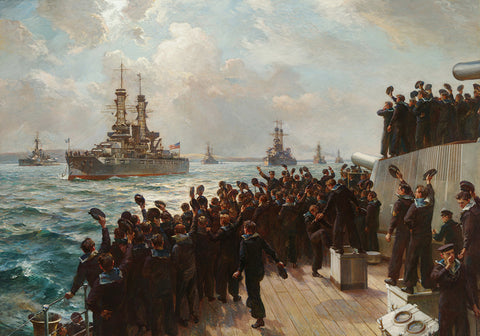
US Naval Might Enters World War I
While Americans were initially reluctant to join the brewing war in Europe in 1914, public opinion began to shift the following spring after German U-boats sank the passenger liner RMS __ Lusitania. By the time the U.S. finally declared war on April 6, 1917, submarine warfare had only intensified. Attacks on its merchant marines were crippling the British Isles, depriving them of much needed supplies and materiel.
Regardless, American admirals remained skeptical about aiding their new allies. They feared that splitting the U.S. fleet could leave North America defenseless should Britain fall. Though the Navy loaned a few destroyers to the British Grand Fleet as a token gesture, it refused to give up any of its precious battleships. Only after months of earnest appeals by their British counterparts did the Americans relent — particularly as British losses become more dire, reaching over 600,000 tons of losses each month.
On Dec. 7, 1917, the U.S. Battleship Division Nine joined forces with the British fleet at Scapa Flow, Scotland. The American warships — New York __ (pictured here, leading), Wyoming, Florida and Delaware — were all older, coal-burning battleships instead of the more advanced oil- powered designs. This was by the Royal Navy’s request, as oil shipments were among the losses attributed to U-boats, while British coal was easier to come by.
In this 1920 painting from the collection of the U.S. Naval History and Heritage Command, prolific English maritime artist B.F. Gribble depicts the enthusiasm with which the crew of the dreadnought battleship HMS Queen Elizabeth __ greeted their Allied shipmates. Within the Grand Fleet the American division served as formidable support for Atlantic shipping and was present for the 1918 surrender of the German High Seas Fleet despite a lack of any direct confrontation between the opposing fleets. Fearing either the confiscation of his ships or a resumption of war, German Admiral Ludwig von Reuter famously ordered the scuttling of his fleet at Scapa Flow on June 21, 1919.
historynet magazines
Our 9 best-selling history titles feature in-depth storytelling and iconic imagery to engage and inform on the people, the wars, and the events that shaped America and the world.
